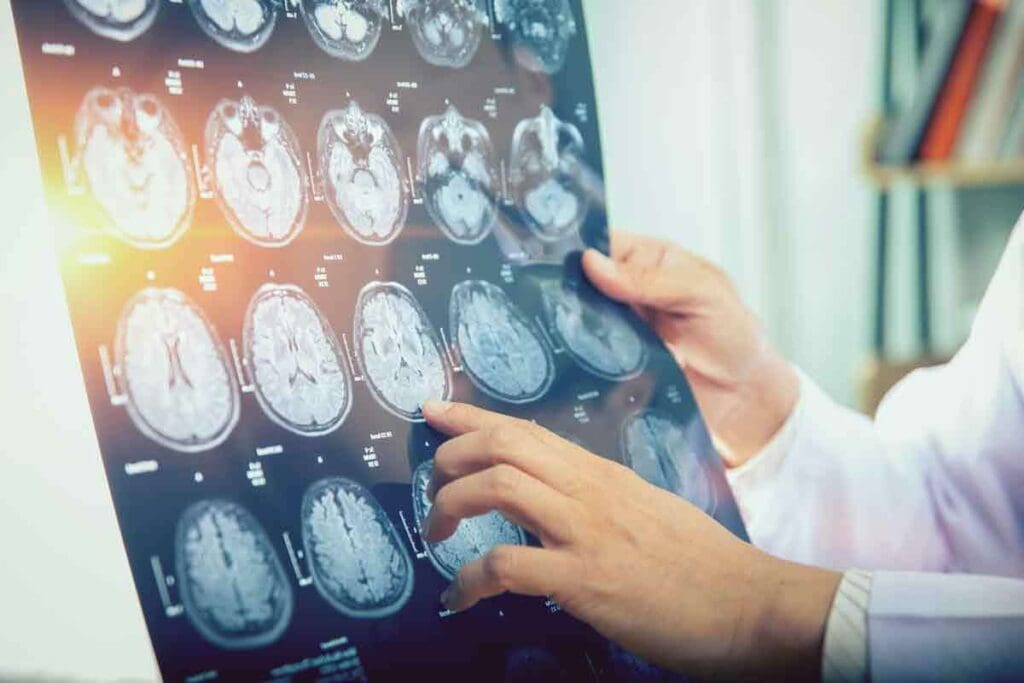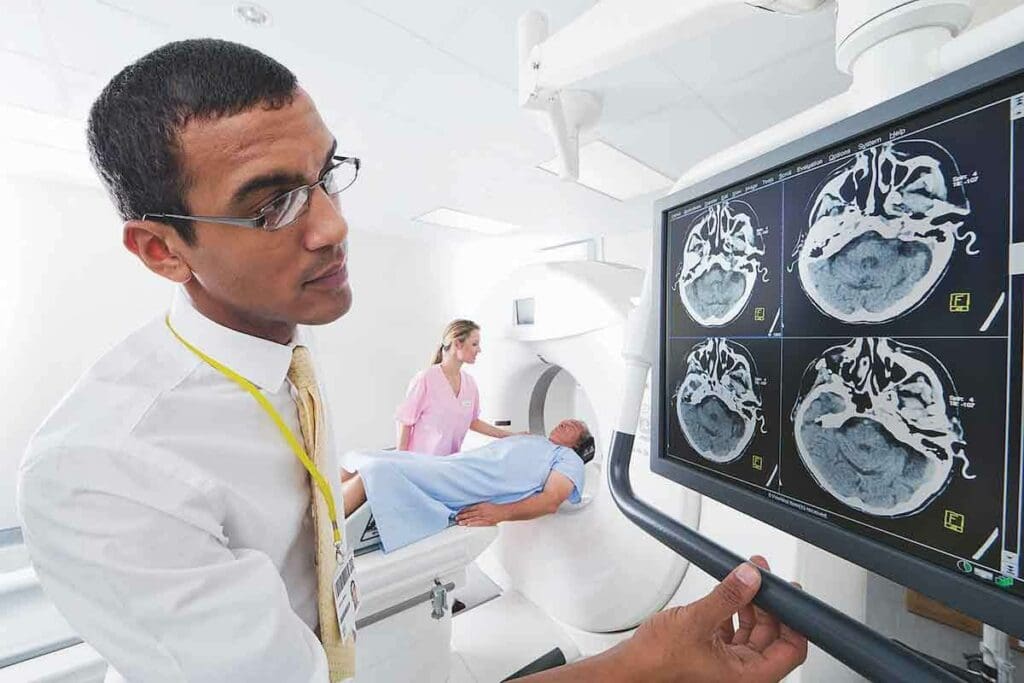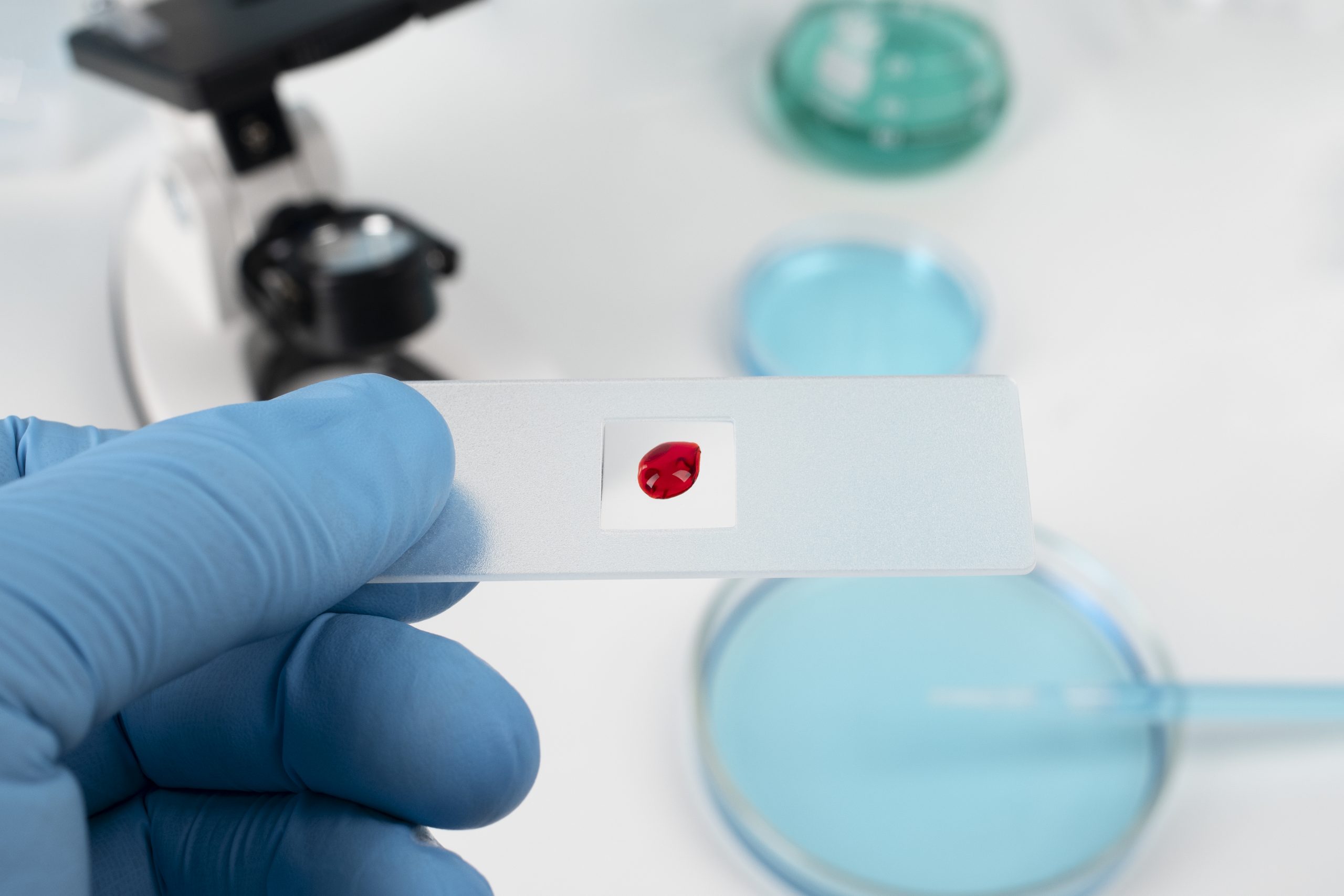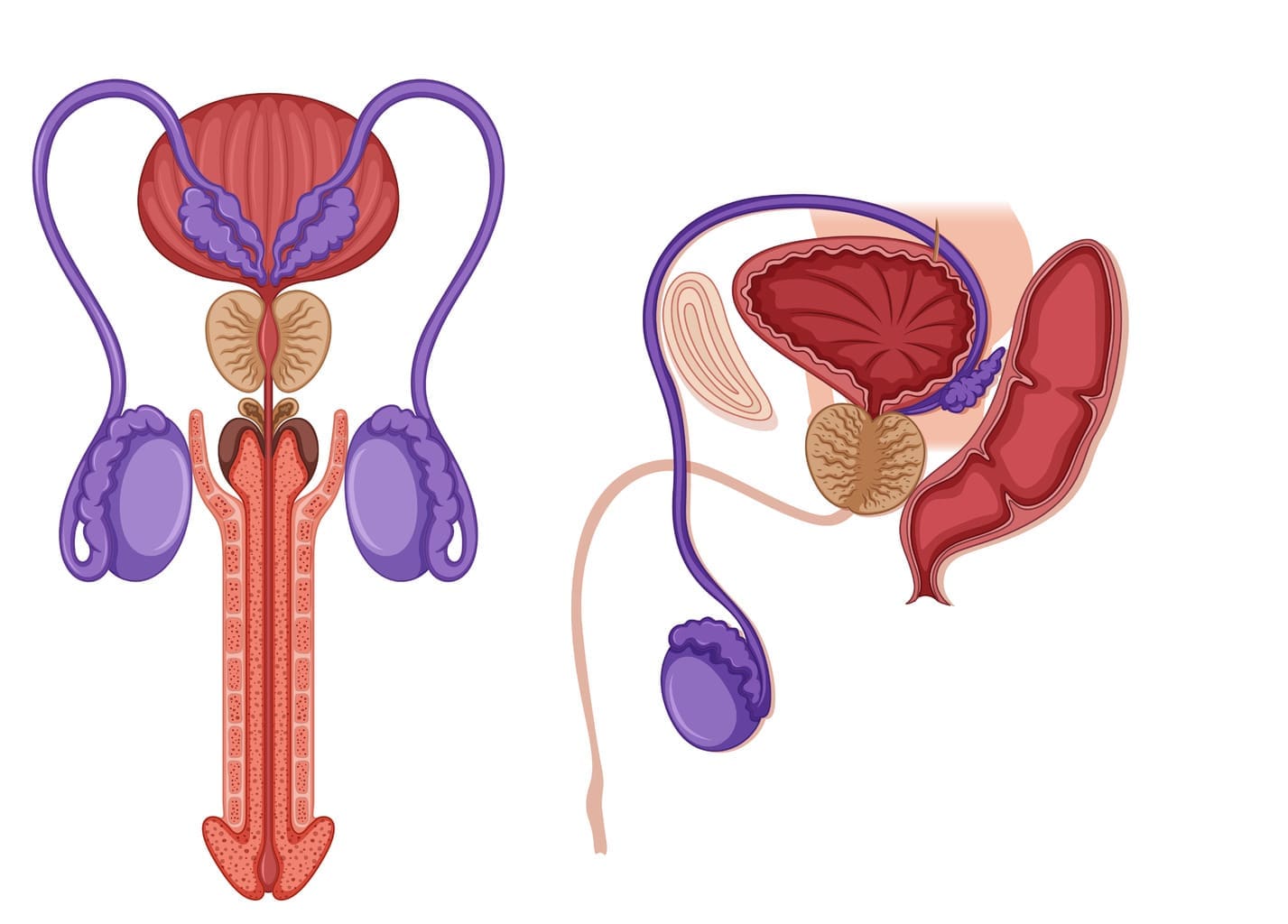Last Updated on November 27, 2025 by Bilal Hasdemir

Understanding the difference between PET CT and MRI is essential when selecting the right diagnostic scan. At Liv Hospital, we prioritize patient care by using the most advanced medical imaging technologies for accurate and reliable diagnoses.
A PET CT scan is excellent for detecting cancer early and monitoring its progression. In contrast, an MRI scan provides highly detailed images of soft tissues without using radiation—making it ideal for examining the brain, spinal cord, joints, and internal organs.
By understanding the difference between PET CT and MRI, doctors can choose the most suitable imaging method for each patient, ensuring precise diagnosis and personalized treatment.
Key Takeaways
- PET CT scans offer combined functional and anatomical imaging.
- MRI provides detailed soft tissue images without radiation.
- PET CT is valuable for early cancer detection and disease monitoring.
- MRI is ideal for analyzing the brain, spinal cord, joints, and organs.
- Understanding the differences between PET CT and MRI is key to accurate diagnoses.
Understanding Medical Imaging: The Basics of Diagnostic Scans

Medical imaging has changed healthcare a lot. It lets us see inside the body without surgery. This field has grown a lot, making diagnosis and care better.
The Evolution of Medical Imaging Technology
Medical imaging started with X-rays. Now, we have Positron Emission Tomography (PET), Computed Tomography (CT), and Magnetic Resonance Imaging (MRI). Each one has its own uses and benefits, helping doctors diagnose better.
A leading expert said, “New imaging tech has greatly helped modern medicine.”
The future of medical imaging is in giving detailed info about the body, not just its shape.
Why Different Scan Types Are Necessary in Modern Medicine
Each scan type is good for different things. MRI is best for soft tissues, CT scans for bones, and PET scans for body functions.
This variety means doctors can pick the best scan for each patient. As imaging tech gets better, we can diagnose and treat more conditions well.
What Is PET CT? Technology and Working Principles

PET CT technology is a big step forward in medical imaging. It mixes PET’s functional info with CT’s structural data. This mix gives a deeper look into the body’s inner workings and structures.
How Positron Emission Tomography Works
Positron Emission Tomography (PET) is a test that uses a radioactive sugar molecule. It finds cancer, neurological issues, and other diseases. A small amount of radioactive tracer is injected into the body.
This tracer goes to areas with lots of activity, like growing cancer cells. The PET scanner picks up signals from this tracer. It makes images that show where the body is not working properly
The Integration of CT in PET CT Scanning
Computed Tomography (CT) scans use X-rays to show the body’s inside. When PET and CT are together in PET CT scans, the CT part shows where the PET activity is. This helps doctors see more clearly where the problem is.
The Metabolic and Anatomical Dual Imaging Advantage
PET CT’s ability to see both metabolic and anatomical info is a big plus. It helps doctors find and track diseases, like cancer. They can see how far the disease has spread and if treatments are working.
In short, PET CT technology is a strong tool for doctors. It combines PET and CT scans to give detailed information. This is key to finding, understanding, and treating many diseases.
What Is MRI? Technology and Working Principles
Magnetic Resonance Imaging (MRI) is a key tool in medicine today. It lets doctors see inside the body without surgery. This has changed how we look at health.
Magnetic Resonance Imaging Fundamentals
MRI works by using magnetic fields and radio waves. First, a strong magnetic field aligns hydrogen atoms in the body. Then, radio waves disturb these atoms, causing them to send signals.
These signals are caught by the MRI machine. They help create detailed images of what’s inside the body.
How Radio Waves and Magnetic Fields Create Images
Making MRI images is a detailed process. It involves magnetic fields and radio waves. When radio waves stop, atoms return to their aligned state, releasing energy.
This energy is what the MRI scanner captures. It uses this energy to build detailed images of the body’s inside. Different tissues return to their aligned state at different rates. This helps MRI tell them apart.
Types of MRI Scans and Their Applications
There are many MRI scans, each for different uses. Functional MRI (fMRI) watches brain activity by looking at blood flow changes. Diffusion MRI checks how water moves in tissues, great for finding strokes.
Other MRI types include Magnetic Resonance Angiography (MRA) for blood vessels and Magnetic Resonance Spectroscopy (MRS) for tissue metabolism.
| Type of MRI | Application | Key Features |
| Functional MRI (fMRI) | Monitoring brain activity | Detects changes in blood flow |
| Diffusion MRI | Detecting strokes and tissue damage | Measures water molecule diffusion |
| Magnetic Resonance Angiography (MRA) | Imaging blood vessels | Highlights vascular structures |
In conclusion, MRI has greatly improved medical imaging. It’s a non-invasive way to see inside the body. Its many uses make it essential in healthcare today.
What Is CT? Technology and Working Principles
Computed Tomography, or CT scans, create detailed images for diagnosing many medical conditions. They use X-rays to show the body’s internal structures. This helps doctors understand what’s going on inside the body.
How Computed Tomography Uses X-rays
CT scans capture images of the body with X-rays from different angles. These images are then put together to show detailed cross-sections of the body. A rotating X-ray tube and detectors move around the patient to gather this data.
The Speed and Efficiency of CT Scanning
CT scans are fast and efficient. Modern scanners can take images in seconds. This speed is very helpful in emergencies, here every second counts.
Common Applications of CT Scans
CT scans are used for many medical needs. They help diagnose injuries, find cancers, and guide treatments. They’re great for seeing dense structures like bones and internal organs.
CT scans are vital in medical practice because they give clear images. This makes them a key tool in today’s healthcare.
The Fundamental Difference Between PET CT and MRI
PET CT and MRI are two advanced imaging methods. They use different technologies to give doctors different kinds of information. Each has its own strengths and uses.
Functional vs. Structural Imaging
PET CT combines PET’s metabolic info with CT’s detailed images. This lets doctors see how tissues work and what they look like. MRI, on the other hand, gives detailed pictures of soft tissues without using harmful radiation.
Key differences in imaging capabilities include:
- PET CT provides both functional and anatomical information
- MRI offers superior soft tissue contrast
- PET CT is great for spotting metabolic changes
- MRI is best for detailed structural studies
Radiation Exposure Considerations
PET CT uses ionizing radiation from both the PET and CT parts. MRI, by contrast, doesn’t use ionizing radiation. This makes MRI safer for pregnant women and kids.
Image Resolution and Detail Comparison
PET CT and MRI both produce high-quality images. But they show different things. MRI is better for soft tissue, like in the brain and muscles. PET CT is key to seeing how tissues work, which helps in cancer diagnosis and treatment tracking.
The choice between PET CT and MRI depends on:
- The specific medical condition being investigated
- The type of information required (functional vs. structural)
- Patient-specific factors, such as radiation exposure concerns
Key Point 1: Imaging Focus and Capabilities
PET CT, MRI, and CT scans have different focuses and abilities. Each is best for certain medical needs. We’ll look at what makes each special, helping us understand their strengths.
PET CT’s Cellular-Level Metabolic Detection
PET CT combines PET’s metabolic info with CT’s body details. This lets it spot changes at the cell level. It’s great for finding and tracking cancer.
For example, PET CT finds active cancer cells. This helps doctors see how aggressive tumors are and if treatments are working.
MRI’s Superior Soft Tissue Contrast
MRI gives clear images of soft tissues like organs and tendons. Its detail is unmatched for the brain, spine, and muscles. It’s key for diagnosing many conditions.
Also, MRI can see blood vessels and find vascular diseases without contrast agents. It’s versatile and safe, showing body parts without radiation.
CT’s Bone and Dense Structure Visualization
CT scans are good for seeing bones and dense tissues. They use X-rays to show detailed body slices. This makes them perfect for checking bone breaks and guiding procedures.
In emergencies, CT scans are often the first choice. They’re fast and give full views of internal injuries.
| Imaging Modality | Primary Strength | Common Applications |
| PET CT | Cellular-level metabolic detection | Cancer diagnosis, staging, and monitoring treatment response |
| MRI | Superior soft tissue contrast | Neurological conditions, musculoskeletal disorders, vascular diseases |
| CT | Bone and dense structure visualization | Assessing bone fractures, detecting calcifications, and emergency imaging |
In conclusion, knowing what each imaging modality does is key. PET CT, MRI, and CT each have unique strengths. Choosing the right one depends on the medical need.
Key Point 2: Radiation Exposure and Safety Concerns
Diagnostic imaging, like PET, SPECT, CT, and CT scans, can expose us to radiation. This raises safety concerns. It’s important to understand radiation exposure to make informed choices.
Understanding Radiation Doses in P ,ET, ,,CT and CT Scans
PET CT and CT scans use radiation to see inside the body. The dose varies by procedure, technology, and patient size. For example, a PET CT scan’s dose is 7-14 mSv, and a CT scan of the abdomen is about 10 mSv.
When looking at risks and benefits, these doses are key, even for repeated scans. For more on PET CT scans and radiation..
MRI’s Radiation-Free Advantage
MRI doesn’t use ionizing radiation. It uses a strong magnetic field and radio waves for images. This makes MRI safer for those needing repeated scans or who are sensitive to radiation, like pregnant women or young kids.
BBut MRIits own safety issues. It’s not safe for people with certain metal implants or those who are claustrophobic.
Contraindications and Safety Considerations for Each Scan Type
Each imaging method has its own safety concerns. For PET CT and CT scans, it’s radiation exposure. MRI focuses on avoiding metal implants and managing claustrophobia.
Comparing these factors helps choose the best imaging technique.
| Imaging Modality | Radiation Exposure | Major Contraindications |
| PET CT | Yes (Variable dose) | Radiation sensitivity, certain medical conditions |
| CT | Yes (Variable dose) | Radiation sensitivity, contrast allergy |
| MRI | No | Metal implants, claustrophobia, and certain medical conditions |
Healthcare providers must talk to patients about these factors for informed decisions. Knowing the differences in radiation and safety helps patients and healthcare providers make better choices.
Key Point 3: Clinical Applications and Disease Detection
Understanding how PET CT, MRI, and CT scans work is key tomanagingg diseases. Each has its own strengths for different needs. We’ll look at how these tools help detect and manage diseases.
Cancer Detection and Staging: PET CT vs MRI vs CT
Finding and staging cancer is a big deal in medical imaging. PET CT shines by showing how active tumors are. This makes it great for tracking cancer and how well treatments work. “PET CT has changed oncology by giving us both function and anatomy,” say experts.
MRI is better at showing soft tissues, which helps with some cancer types. CT scans are fast and good for spotting many cancers, often in emergencies.
Neurological Conditions: When MRI Excels
MRI is top-notch for brain and spinal cord imaging. It’s the go-to for diagnosing conditions like multiple sclerosis, stroke, and spinal injuries. Its detailed soft tissue images without radiation are a big plus.
A leading neurologist says, “MRI is essential in neurology for its high sensitivity and specificity in finding lesions and abnormalities.”
Emergency and Trauma Situations: The Role of CT
In emergencies, speed and accuracy are everything. CT scans are often first because they’re fast and good at spotting injuries like bleeding, fractures, and head trauma. Their quickness can be a lifesaver.
Key Point 4: Patient Experience and Procedure Duration
The experience of patients during medical imaging procedures is shaped by several factors. These include preparation, how long the procedure lasts, and how comfortable it is. As we look at PET CT, MRI, and CT scans, knowing these details helps both patients and healthcare providers make better choices.
Preparation Requirements for Each Scan Type
Preparation for medical imaging scans varies a lot. For PET CT scans, patients usually need to fast for a few hours beforehand. They might also have to avoid certain medications or activities.
MRI scans require less preparation. Patients must remove all metal objects and may need to wear a special gown. CT scans need little preparation, but sometimes contrast dye is used, which requires extra steps.
| Scan Type | Preparation Requirements |
| PET CT | Fasting, avoiding certain medications |
| MRI | Removing metal objects, a special gown |
| CT | Little preparation, possible contrast dye |
Duration and Comfort Comparison
The length of each scan affects patient comfort. PET CT scans usually take about 30 minutes to an hour. MRI scans can last from 15 to 90 minutes, depending on the type and complexity. CT scans are quick, often done in just a few minutes.
Comfort levels also differ. MRI scans can be tough for those who are claustrophobic because of their enclosed design. PET CT and CT scans are more open, but PET CT involves some radiation and may take longer.
“The comfort and duration of medical imaging procedures play a significant role in the overall patient experience.” – Medical Imaging Expert
Claustrophobia and Noise Considerations
Claustrophobia is a big issue for MRI scans because of their enclosed nature. Open MRI machines are available for those who are claustrophobic, making the experience more comfortable. MRI scans also produce loud knocking sounds, which can be a problem. Ear protection is often given to help with this.
In conclusion, the experience and duration of PET CT, MRI, and CT scans vary. This is due to differences in preparation, scan length, comfort, and specific issues like claustrophobia and noise. Understanding these factors helps patients prepare better for their diagnostic procedures.
Key Point 5: Accuracy and Diagnostic Value Comparison
PET CT, MRI, and CT scans each have their strengths and limitations. Knowing these differences helps healthcare providers make better decisions for patient care.
Detection Rates for Various Conditions
The detection rate of a diagnostic modality shows how well it can find a specific condition. PET CT scans are great at finding cancer because they show metabolic activity. They are often used in oncology to spot tumors and check their activity.
MRI is better at seeing soft tissues. It’s the top choice for diagnosing neurological issues, musculoskeletal disorders, and some cancers. Its detailed images help understand soft tissue structure and integrity.
| Modality | Cancer Detection | Neurological Conditions | Musculoskeletal Disorders |
| PET CT | High | Moderate | Low |
| MRI | Moderate | High | High |
| CT | Moderate | Low | Moderate |
False Positive and Negative Considerations
False positives and negatives are big concerns in diagnostic imaging. A false positive can cause unnecessary worry and more tests. A false negative can delay diagnosis and treatment. PET CT scans can sometimes show false positives due to inflammation or infection.
MRI can also have issues. For example, metal artifacts or certain contrast agents can cause image misinterpretation.
Which Is More Accurate: PET Scan, CT Scan, or MRI?
The accuracy of PET CT, CT, and MRI varies by clinical context. For cancer staging and metabolic activity, PET CT is usually the most accurate. For detailed soft tissue imaging and neurological conditions, MRI is best.
In conclusion, choosing between PET CT, MRI, and CT scans depends on the patient’s needs. It’s important to consider each modality’s strengths and limitations.
Key Point 6: Cost, Accessibility, and Insurance Factors
When choosing medical imaging, cost, access, and insurance are key. We’ll look at these to help patients and doctors make better choices.
Average Costs of PET CT, MRI, and CT Scans
The prices for PET CT, MRI, and CT scans vary a lot. This depends on where you are, who you see, and the technology used. PET CT scans are usually the priciest because of the tech and the radioactive tracer.
| Scan Type | Average Cost Range (USD) |
| PET CT | $1,000 – $3,000 |
| MRI | $400 – $3,500 |
| CT | $300 – $2,500 |
Keep in mind, these are just estimates. Actual costs can change. Always check with your doctor or insurance for exact prices.
Insurance Coverage Considerations
Insurance for PET CT, MRI, and CT scans varies by provider and policy. Usually, they’re covered if needed. But you might have to pay for things like deductibles and copays.
Tips for Patients:
- Find out what your insurance covers.
- Ask about any costs you’ll have to pay.
- Talk to your doctor about cheaper options if you’re worried about cost.
Availability and Wait Times in Different Healthcare Settings
Where you can get PET CT, MRI, and CT scans differs a lot. Big hospitals and special imaging centers usually have the latest tech.
Wait times also vary. CT scans are often quicker for urgent cases. MRI and PET CT scans might take longer because they’re more complex.
“The choice of imaging modality should be guided by clinical judgment, taking into account the patient’s specific condition, the diagnostic question being addressed, and the availability of resources.” –
Radiological Society of North America
In summary, while cost, access, and insurance are important, patients should talk to their doctors. Together, they can decide the best imaging for each person’s needs.
Key Point 7: Future Developments in Medical Imaging
The future of medical imaging is exciting, with new technologies on the horizon. These advancements will change how we diagnose diseases. Several areas are making big strides.
Emerging Technologies in PET CT
PET CT technology is getting better fast. New scanner designs and algorithms are giving us clearer images. This means doctors can make more accurate diagnoses.
Digital PET CT scanners are leading the way. They offer better sensitivity and detail than old systems. This is a big step forward.
New tracers for PET CT scans are also being developed. These tracers can spot more conditions, like cancer and brain disorders. This will make PET CT scans even more useful.
Innovations in MRI Scanning
MRI technology is also improving. High-field MRI and functional MRI (fMRI) are becoming more common. High-field MRI gives us sharper images, while fMRI maps brain function. This is key for diagnosing and treating brain conditions.
Portable MRI machines are another big development. They let MRI scans reach patients in remote areas. This could change how we diagnose and treat diseases in hard-to-reach places.
The Integration of AI in Diagnostic Imaging
Artificial Intelligence (AI) is changing medical imaging. AI can analyze images, find problems, and predict patient outcomes. This is a huge leap forward.
AI is making images clearer and scans shorter. For example, AI can reconstruct images from less data. This means patients don’t have to wait as long for scans.
| Technology | Current Advancements | Potential Impact |
| PET CT | Digital PET CT scanners, new tracers | Higher resolution images, better diagnostic accuracy |
| MRI | High-field MRI, functional MRI, portable MRI | Improved image resolution, expanded accessibility |
| AI in Diagnostic Imaging | Image analysis, predictive analytics | Enhanced diagnostic accuracy, personalized medicine |
As these technologies grow, patient care will get better. The future of medical imaging looks bright. New technologies will change how we fight diseases.
Conclusion: Making Informed Decisions About Medical Imaging
Understanding the differences between PET CT, MRI, and CT scans is key. It helps us make better choices when it comes to medical tests. Knowing what each technology does best helps both patients and doctors decide on the right test.
PET CT is great at showing how active cells are. MRI gives the best view of soft tissues. CT scans are fast and clear for dense structures. Each has its own strengths for different medical needs.
When choosing medical imaging, we must think about safety, accuracy, and comfort. By considering these, we can use PET CT, MRI, and CT scans to help patients more effectively.
Medical imaging is always getting better. Keeping up with new tech is important. This way, we can use these tools to improve how we diagnose and care for patients.
FAQ
What is the main difference between PET CT and MRI scans?
PET CT scans help find cancer and track its spread. MRI scans are better for soft tissues, the brain, spinal cord, and joints.
Which is more accurate: PET scan, CT scan, or MRI?
Accuracy varies by condition. PET scans are top for cancer detection. MRI is best for soft tissues. CT scans are great for emergencies and detailed views.
What are the radiation safety concerns for PET CT and CT scans?
Both PET CT and CT scans use radiation, which is a worry for patients needing many scans. MRI doesn’t use radiation.
How do I prepare for a PET CT, MRI, or CT scan?
Preparing for each scan is different. For PET CT, fasting is needed for a few hours. MRI requires removing metal and wearing a special gown. CT scans might need a contrast drink.
Are there any contraindications for MRI scans?
Yes, MRI is not for patients with metal implants or certain conditions. Tell your doctor about any implants or conditions before an MRI.
How long do PET, C,,T and MRI scans typically take?
Scan times vary. PET CT scans last about 30 minutes to an hour. MRI scans can take 15 minutes to several hours. CT scans are quick, lasting just a few minutes.
Can I undergo a PET CT or MRI scan if I am claustrophobic?
MRI scans might be hard for those with claustrophobia because of the enclosed spaBut. Bu, some MRI machines are open, and sedation is an option. PET CT scans are less likely to cause claustrophobia.
What are the costs associated with PET CT, MRI, and CT scans?
Costs differ by location, provider, and insurance. PET CT scans are often pricier than CT scans. MRI costs can vary a lot.
Are PET CT, MRI, and CT scans covered by insurance?
Insurance coverage varies by provider and policy. Check with your insurance to see what’s covered.
What are the emerging technologies in medical imaging?
New technologies include better PET CT, MRI, and AI. These advancements improve diagnosis and care.
References
- Cancer Research UK. (2022). How PET-CT scans help with cancer diagnosis and treatment. https://www.cancerresearchuk.org/about-cancer/diagnosis/tests/pet-ct-scan
- Kyme, A., Ellis, M., Yang, Y., et al. (2018). Advances in PET/CT technology and the role of imaging in cancer management. British Journal of Radiology, 91(1083), 20170268. https://www.ncbi.nlm.nih.gov/pmc/articles/PMC5817410/






